Bosch HEIP054U, HEIP054C, HEI8054C User Manual
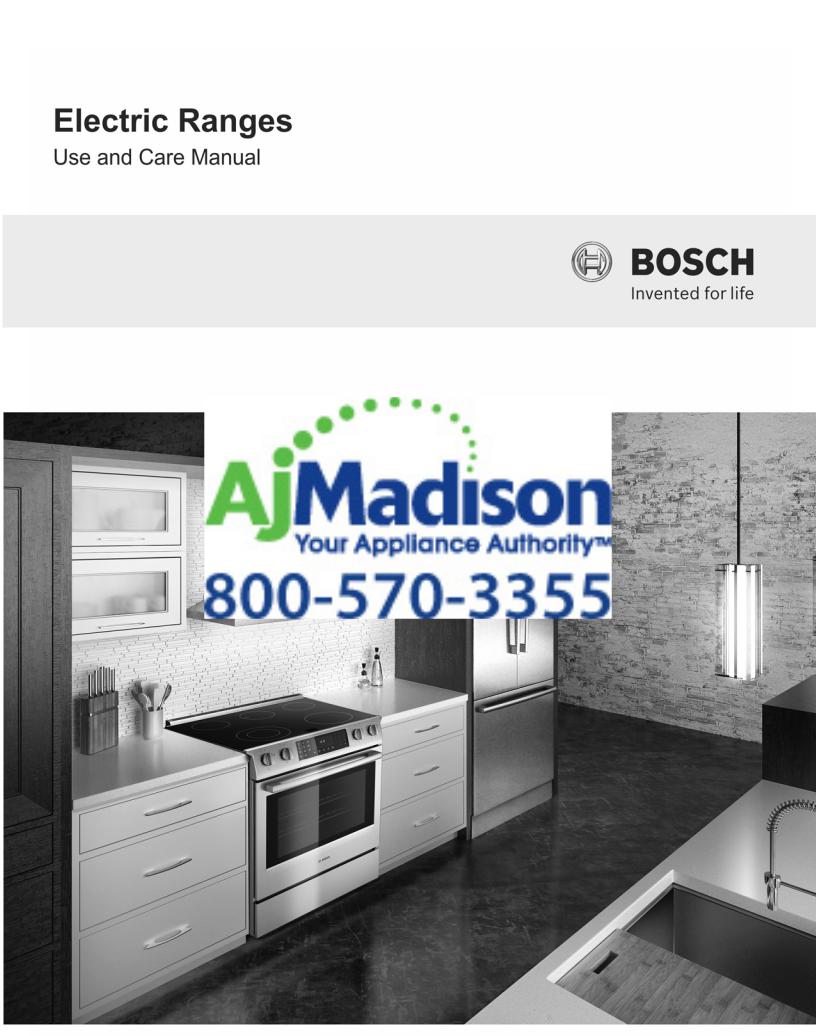
Slide-In Ranges
HEI8054U, HEI8054C, HEIP054U, HEIP054C
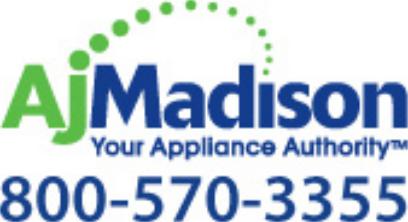
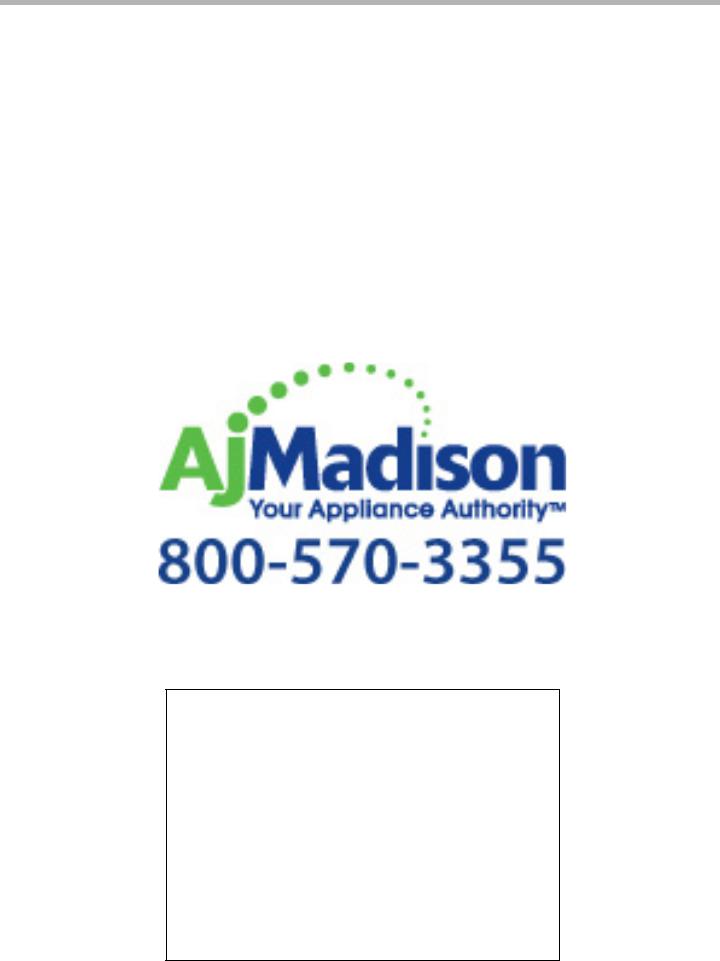
Table of Contents |
|
About This Manual ......................................................... |
1 |
How This Manual Is Organized ..................................... |
1 |
Safety ............................................................................ |
2 |
Important Safety Instructions ......................................... |
2 |
Getting Started .............................................................. |
6 |
Parts and Accessories ................................................... |
8 |
Before Using the Appliance for the First Time ............... |
9 |
Operation - Cooktop .................................................... |
10 |
About the Cooktop........................................................ |
10 |
Operation - Oven ......................................................... |
12 |
Operation ..................................................................... |
13 |
About the Oven ............................................................ |
13 |
Operation - Warming Drawer (some models) .............. |
19 |
About the Warming Drawer ......................................... |
19 |
Operation ..................................................................... |
19 |
Getting the Most Out of Your Cooktop ........................ |
20 |
Getting the Most Out of Your Oven ............................. |
21 |
Getting the Most Out of Your Warming Drawer ........... |
26 |
Cleaning and Maintenance .......................................... |
28 |
Care and Cleaning |
|
Maintenance |
|
Service |
|
Self Help |
|
Warranty |
|
This Bosch Appliance is made by
BSH Home Appliances Corporation
1901 Main Street, Suite 600
Irvine, CA 92614
Questions?
1-800-944-2904
www.bosch-home.com/us
We look forward to hearing from you!
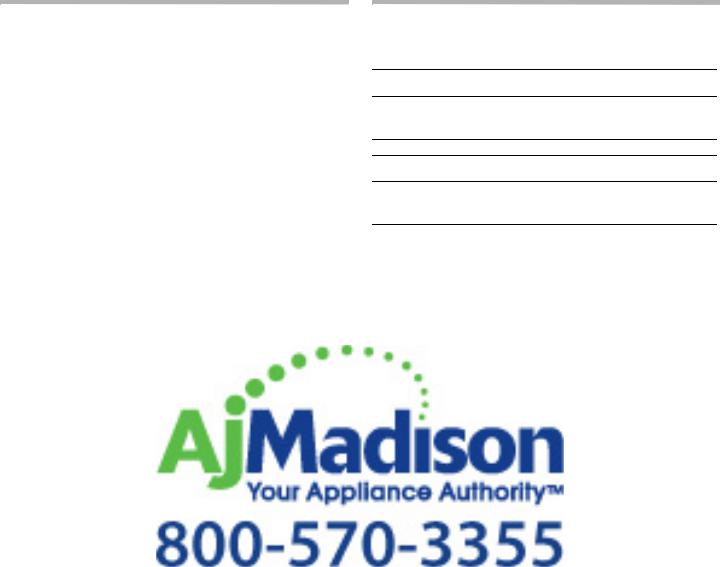
About This Manual
How This Manual Is Organized
This manual contains several sections:
•The Safety section describes important procedures that can ensure your safety while using the appliance.
•The Getting Started section describes the features and functionality of the appliance, including a description of how to set it up and operate it.
•The Operation section describes how to operate and get the best performance out of each component.
•The Cleaning and Maintenance section describes how to clean and maintain the appliance.
•The Service section includes troubleshooting tips and your warranty.
•Before using your appliance, be sure to read this manual. Pay special attention to the Important Safety Instructions located at
Safety Definitions
9WARNING
This indicates that death or serious injuries may occur as a result of non-observance of this warning.
9CAUTION
This indicates that minor or moderate injuries may occur as a result of non-observance of this warning.
NOTICE: This indicates that damage to the appliance or property may occur as a result of non-compliance with this advisory.
Note: This alerts you to important information and/or tips.
English 1

9 IMPORTANT SAFETY INSTRUCTIONS
READ AND SAVE THESE INSTRUCTIONS
Safety
9WARNING
TIP OVER HAZARD!
A child or adult can tip the range over and be killed. Verify that the anti-tip
bracket is securely installed. Ensure the anti-tip bracket is engaged whenever the range is moved to a new location.
Do not operate the range without the anti-tip bracket in place. Failure to follow the instructions in this manual can result in death or serious burns to children and adults.
Check for proper tip bracket. Carefully
from the back to ensure engages the range leg range should not move
Proper Installation and
•WARNING: When appliance has been Read all instructions ca precautions will reduce
fire, and injury to persons. When using kitchen appliances, basic safety precautions must be followed, including those in the following pages.
•Have the installer show you the location of the circuit breaker or fuse. Mark it for easy reference.
•This appliance must be properly installed and grounded by a qualified technician. Connect only to a properly grounded outlet. Refer to Installation Instructions for details.
•All ranges can tip. Injury to persons could result. Install anti-tip device packaged with range. Verify that the anti-tip devices are engaged. See Installation Instructions.
•This appliance is intended for normal family household use only. It is not approved for outdoor use. See the Warranty. If you have any questions, contact the manufacturer.
•Do not store or use corrosive chemicals, vapors, flammables or nonfood products in or near this appliance. It is specifically designed for use when heating or cooking food. The use of corrosive
chemicals in heating or cleaning will damage the appliance and could result in injury.
•Do not operate this appliance if it is not working properly, or if it has been damaged. Contact an authorized servicer.
•Do not cook on a broken cooktop. Cleaning solutions and spillovers may create a risk of electric shock.
•Do not obstruct oven vents.
•Do not repair or replace any part of the appliance unless specifically recommended in this manual. Refer all servicing to a factory authorized service center.
•In the event of an error the display flashes and beeps continuously. If this happens during self-clean, disconnect appliance from the power supply and call a
display flashes and beeps appliance from the power technician.
protective liners to line any the oven bottom. result in a risk of electric
warming drawer should off the appliance and
circuit breaker box.
•Use this appliance only for its intended use as described in this manual. For example, never use the appliance for warming or heating the room. Never use the appliance for storage.
•Do not allow aluminum foil, plastic, paper or cloth to come in contact with a hot burner or grate. Do not allow pans to boil dry.
•If the cooktop is near a window, forced air vent, or fan, be certain that flammable materials such as window coverings do not blow over or near the burners or elements. They could catch on fire.
•Always have a working smoke detector near the kitchen.
•Never leave the cooktop unattended when in use. Boilovers cause smoking and greasy spillovers may ignite.
English 2
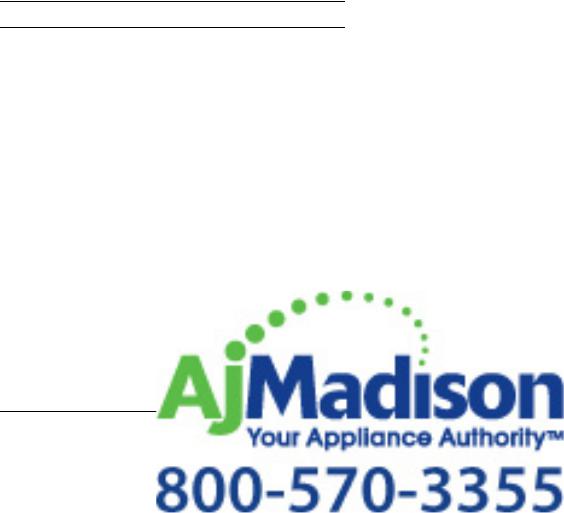
9 IMPORTANT SAFETY INSTRUCTIONS
READ AND SAVE THESE INSTRUCTIONS
9WARNING
TO REDUCE THE RISK OF PERSONAL INJURY IN THE EVENT OF A GREASE FIRE, OBSERVE THE FOLLOWING:
contact heating elements or interior surfaces of oven until they have had sufficient time to cool. Other surfaces of the appliance may become hot enough to cause burns. Among these surfaces are oven vent openings, surfaces near these openings and oven doors.
•SMOTHER FLAMES with a close-fitting lid, cookie sheet, or metal tray, then turn off the burner. EXERCISE CAUTION TO PREVENT BURNS. If the flames do not go out immediately, EVACUATE AND CALL THE FIRE DEPARTMENT.
•NEVER PICK UP A FLAMING PAN—You may be burned.
•DO NOT USE WATER, including wet rags or towels—a violent steam explosion will result.
•Use an extinguisher ONLY if:
1)You know you have a CLASS ABC extinguisher
operate it.
2)The fire is small where it started
3)The fire
•You can fight the
•In the event that personal
drop and roll immediately
•Whenever possible, do system during a cooktop through fire to turn it off
•Have an appropriate fire extinguisher available, nearby, highly visible and easily accessible near the oven.
•Smother flames from food fires other than grease fires with baking soda. Never use water on cooking fires.
Burn Prevention
•DO NOT TOUCH COOKTOP ELEMENTS OR AREAS NEAR COOKTOP ELEMENTS - Cooktop elements may be hot even though they are dark in color. Areas near cooktop elements may become hot enough to cause burns. During and after use, do not touch, or let clothing, potholders, or other flammable materials contact cooktop elements or areas near them until they have had sufficient time to cool. Among these areas are the cooktop and areas facing the cooktop.
•DO NOT TOUCH HEATING ELEMENTS OR INTERIOR SURFACES OF OVEN - Heating elements may be hot even though they are dark in color. Interior surfaces of an oven become hot enough to cause burns. During and after use, do not touch, or let clothing, potholders, or other flammable materials
•Exercise caution when opening the appliance. Standing to the side, open the door (or drawer) slowly and slightly to let hot air and/or steam escape. Keep your face clear of the opening and make sure there are no children or pets near the unit. After the release of hot air and/or steam, proceed with your cooking. Keep doors shut unless necessary for cooking or cleaning purposes. Do not leave open doors unattended.
•Do not heat or warm unopened food containers. Buildup of pressure may cause the container to burst and cause injury.
•Always place oven racks in desired location while oven
while oven is hot, do heating elements.
Moist or damp potholders burns from steam. Do not
elements. Do not use a
cooking at high heat or Crepes Suzette, Cherries Flambe’).
cooktop only when and splattering, heat oil
-medium setting. Hot oil is burns and injury.
•Never move a pan of hot oil, especially a deep fat fryer. Wait until it is cool.
•Secure all loose garments, etc. before beginning. Tie long hair so that it does not hang loose, and do not wear loose fitting clothing or hanging garments, such as ties, scarves, jewelry, or dangling sleeves.
•Avoid reaching or leaning over the appliance. Be aware that certain clothing and hair sprays may contain flammable chemicals that could be ignited if brought in contact with hot surface units or heating elements and may cause severe burns.
•Do not touch interior surface of the drawer while it is in use. The interior of the drawer could become hot enough to cause burns. Allow drawer and rack (if equipped) to cool before handling.
•WARNING: To prevent burns, do not remove drawer while hot. Be sure drawer is empty before removing.
•Whenever possible, do not operate the ventilation system during a cooktop fire. However, do not reach through fire to turn it off.
English 3

9 IMPORTANT SAFETY INSTRUCTIONS
READ AND SAVE THESE INSTRUCTIONS
9WARNING
Use this appliance only for its intended use as described in this manual. NEVER use this appliance as a space heater to heat or warm the room. Doing so may result in carbon monoxide poisoning and overheating the appliance. Never use the appliance for storage.
9WARNING
NEVER cover any slots, holes or passages in the oven bottom or cover an entire rack with materials such as aluminum foil. Doing so blocks air flow through the oven and may cause carbon monoxide poisoning. Aluminum foil linings may also trap heat, causing a fire hazard.
•Never move a pan of Wait until it is cool.
•Use caution when content (e.g. rum, brandy, Alcohol evaporates at risk of burning as the
the oven. Use only small and open the oven door
Child Safety
•When children become
appliance, it is the responsibility of the parents or legal guardians to ensure that they are instructed in safe practices by qualified persons.
•Do not allow anyone to climb, stand, lean, sit, or hang on any part of an appliance, especially a door, warming drawer, or storage drawer. This can damage the appliance, and the unit may tip over, potentially causing severe injury.
•Do not allow children to use this appliance unless closely supervised by an adult. Children and pets should not be left alone or unattended in the area where the appliance is in use. They should never be allowed to play in its vicinity, whether or not the appliance is in use.
9CAUTION
Items of interest to children should not be stored in an appliance, in cabinets above an appliance or on the backsplash. Children climbing on an appliance to reach items could be seriously injured.
Cleaning Safety
9WARNING
State of California Proposition 65 Warnings:
This product contains chemicals known to the State of California to cause cancer, birth defects or other reproductive harm.
•IMPORTANT SAFETY NOTICE: The California Safe Drinking and Toxic Enforcement Act requires the
publish a list of substances cancer, birth defects or
requires businesses to exposure to such
gas cooking fuel and the -cleaning can generate
monoxide.The fiberglass gives off very small
during the first several lists formaldehyde as a Carbon monoxide is a
toxicity. Exposure to minimized by:
1)Providing good ventilation when cooking with gas.
2)Providing good ventilation during and immediately after self cleaning the oven.
3)Operating the unit according to the instructions in this manual.
•Do not clean the appliance while it is still hot. Some cleaners produce noxious fumes when applied to a hot surface. Wet cloths or sponges can cause burns from steam.
•When self-cleaning, confirm that the door locks and will not open. If the door does not lock, do not run SelfClean. Contact service.
•Birds have very sensitive respiratory systems. Keep pet birds out of the kitchen or other rooms where kitchen fumes could reach them. During self clean, fumes are released that may be harmful to birds. Other kitchen fumes such as overheating margarines and cooking oils may also be harmful.
•Keep oven free from grease build up.
English 4
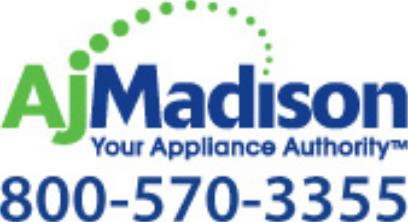
9 IMPORTANT SAFETY INSTRUCTIONS
READ AND SAVE THESE INSTRUCTIONS
Cookware Safety |
Food Safety |
|
• Do not place food directly on oven bottom. |
• CAUTION: To maintain food safety, follow these |
|
• Follow the manufacturer’s directions when using |
guidelines: |
|
|
cooking or roasting bags. |
1) DO NOT use a warming drawer to heat cold food |
• Hold the handle of the pan when stirring or turning |
(exception: it is safe to use the drawer to crisp |
|
|
food. This helps prevent spills and movement of the |
crackers, chips or dry cereal and to warm plates. |
|
pan. |
2) Be sure to maintain proper food temperature. The |
• Use Proper Pan Size. The use of undersized cookware |
USDA recommends holding hot food at 140°F or |
|
|
will expose a portion of the heating element or burner |
warmer. |
|
to direct contact and may result in ignition of clothing. |
3) DO NOT warm food for longer than one hour. |
|
Select cookware having flat bottoms large enough to |
|
|
cover the surface heating unit. This appliance is |
|
|
equipped with one or more surface units of different |
|
|
size. Proper relationship of cookware to heating |
|
|
element or burner will also improve efficiency. |
|
• Cookware not approved for use with glass ceramic |
|
|
|
cooktops may break with sudden temperature |
|
|
changes. Use only pans |
|
|
ceramic cooktops (only |
|
|
heatproof glass, ceramic, |
|
|
utensils are suitable). |
|
|
for further details. |
|
• |
Always position handles |
|
|
not extend over adjacent |
|
|
edge of the cooktop. |
|
|
spills and burns. |
|
• |
CAUTION: Plastic |
|
|
in direct contact with |
|
|
melts onto the drawer, |
|
English 5
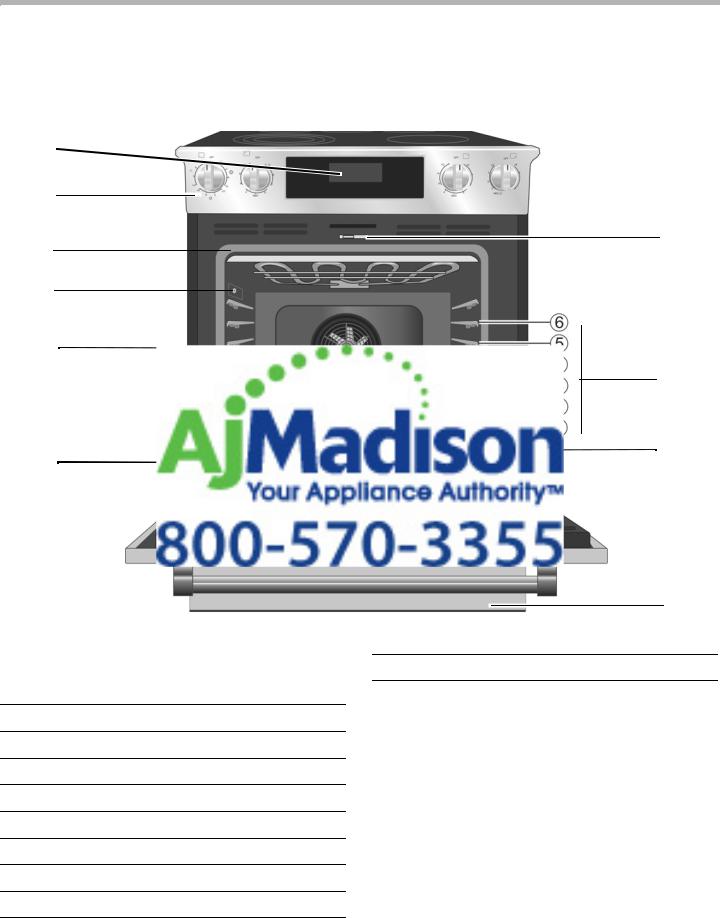
Getting Started
Parts and Accessories
Your appliance may vary slightly.
1
2
3 
5 
6
9
Range Parts Key
1Oven Control Panel
2Cooktop Control Knobs
3Door Gasket
4Door Latch
5Probe Jack
6Convection Fan
7Rack Position Guides with 6 rack positions
8Oven Bottom
9Door Hinge
4
7
8
10
10 Warming Drawer
Range Features
Radiant Elements
The radiant element uses a wire ribbon located under the glass ceramic surface to provide the heat for cooking. The radiant element will cycle on and off by design (see Temperature Limiter).
Single Element
The single element consists of only one radiant element in the heating area. The unit temperature can be adjusted from Hi to Lo to provide the desired cooking performance.
English 6

Double Element (some models)
The dual element consists of two (a small and a large) radiant element within the same heating area. Either the small element, or both elemetns may be selected for use.
Triple Element (some models)
The triple element consists of three (small, medium and large) radiant ribbon elements within the same heating area. Either the small element, the small and medium element or all three elements may be selected for use, in order to better match the size of cookware.
Power Element (some models)
This element is used fro faster time to boil and low simmer, all in one element. There are two elements that are the full size of the cooking zone.
Warming Zone
The warming element consists of one radiant element. The temperature is preset to the
the oven control panel.
Retained Heat
The glass cooking surface the element(s) have been may be used to hold foods short time. If a hot surface working or cleaning around still hot.
Temperature Limiter
Each radiant heating element has its own sensor to protect the glass cooking surface from extreme high temperatures. The limiters will operate automatically by cycling the element off regardless of the cook setting.
Although cycling is normal, any one of the following conditions can activate the limiter and cause it to cycle on and off more than usual:
•The base of the pan is not making full contact with the heating surface (due to a warped or uneven base).
•The pan is too small for the element.
•The pan has boiled dry.
•The material or shape of the pan is slow to transfer the heat.
Hot Surface Indicator
The cooktop displays a hot indicator light to show when the cooking surface is too hot to touch. If a hot surface light is on, use caution when working or cleaning around the cooktop as the cooktop is still hot.
Oven Features
Cooling Fan
The cooling fan runs during all cooking modes. The fan can be heard when it is running, and warm air may be felt as it is released from the oven vent. The fan may also run after the oven is off.
Convection Fan
The convection fan operates during any convection mode. When the oven is operating in the convection mode, the fan will turn off automatically when the door is opened. The convection fan does run during self-clean, although not at the beginning of the mode. May run during self clean.
Note: On some models, the convection fan also runs during preheat for the bake mode.
Oven Bottom
wer heating element. As a from damage and spills.
oven bottom.
top back of the range..
the vent before, during and steam escaping from the in this area. This area
in use. Do not block the circulation.
9CAUTION
Do not use aluminum foil or protective liners to line any part of an appliance, especially soven bottom. Installation of these liners may result in a risk of electric shock or fire.
Automatic Shutoff
The oven will automatically shut off after 24 hours.
Self-Cleaning
The oven features a self-cleaning function that eliminates the manual labor involved with cleaning your oven.
Indicators and Other Features
Default Settings - The cooking modes automatically select the default temperature. These can be changed when a different one is needed.
English 7
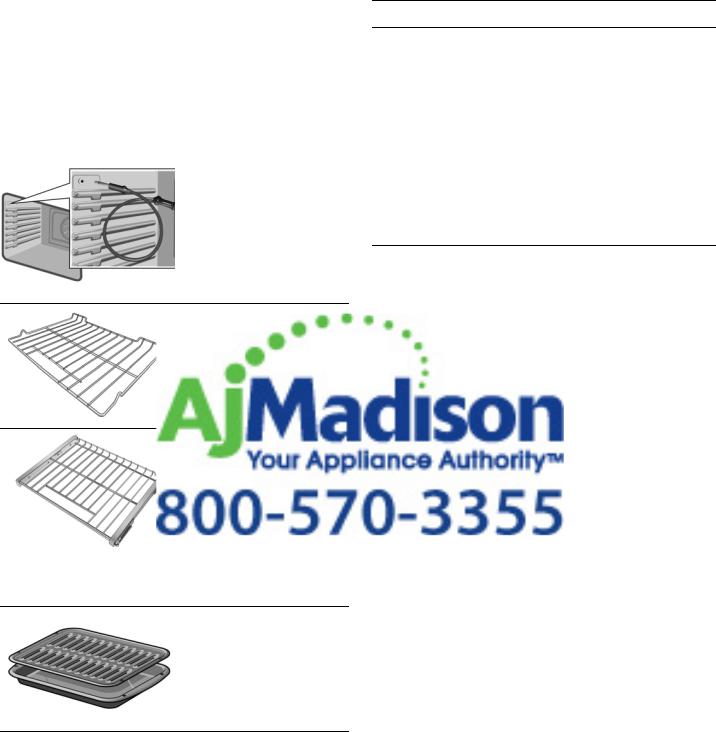
E Number Codes -These codes display when there is a problem with the range.
Stand By Mode
Stand by mode means that the oven is on but no cooking mode or timer is running.
Accessories
Probe (some models)
The probe can be used to determine the internal doneness or the end temperature of many foods, especially meats and poultry.
Do not clean in the selfclean oven or dishwasher.
Flat Rack
and remove dishes from oven when done.
Do not clean in the selfcleanoven.
Broil pan and grid
Use for broiling and roasting. Do not clean in the self-clean oven.
Back Guard
Four inch low back guard.
Inserting Racks
9CAUTION
To avoid burns, place oven racks in desired positions before turning oven on. Always use oven mitts when the oven is warm. If a rack must be moved while the oven is hot, do not let oven mitts contact hot heating elements.
Use caution when removing an oven rack from the lowest rack position to avoid contact with the hot oven door.
To avoid possible injury or damage to the appliance, ensure racks are installed exactly per installation instructions and not backwards or upside down.
English 8

Flat Rack
The rack is designed with a stop so it will stop before coming completely out of the oven and not tilt.
To insert the flat rack into the oven:
1.Grasp rack firmly on both sides.
2.Insert rack (see picture).
3.Tilt rack up (A) to allow rack to slide under the portion of the rack guide
4.When the back of the front of the rack to a the rest of the way in. The rack should be
To remove the flat rack from
1.Grasp rack firmly on both sides and pull rack toward you.
2.When the stop is reached, tilt rack up so that the upwardly sloped back of the rack can pass under the stop. Pull the rack the rest of the way out.
Telescopic Rack (some models)
To insert the telescopic rack into the oven:
1.Slide the rack in evenly until the rear of the rack is about 2 inches from the back of the oven.
2.Tilt the front of the rack up about 3/4’s of an inch (A) and finish pushing the rack all the way back (B)
Note: Avoid striking the oven light cover glass when pushing the rack into position.
English 9
3.The back of the telescopic rack drops into place.
4.Pull the rack forward to engage the bottom of the rack onto the rear of the rack position guide.
5.Lower the front of the rack to finish seating it on the rack guide. The rack should feel stable when properly seated.
6.Slide the movable part of the telescopic rack in and out
able to move freely and the telescopic rack is
damage to the appliance, is installed exactly per not backwards or upside
from the oven:
rack assembly about 1/2 inch and push the rack to the rear about 3/4 inch. This allows the rack to disengage from the rack position guide.
2.Lift the rear of the telescopic rack assembly so it clears the rack position guide and gently pull the rack from the oven.
Note: Take care to avoid pulling the rack unevenly which will cause it to bind during removal, catching on the oven walls.
Before Using the Appliance for the First Time
•Remove all packing materials and labels from range. Remove packing materials from inside the oven and inside the drawer.
•While cool, wipe with a clean, damp sponge and dry.
•Apply the glass ceramic cooktop cleaner to the glass ceramic cooktop. Buff with a clean cloth. See Care and Cleaning Section.
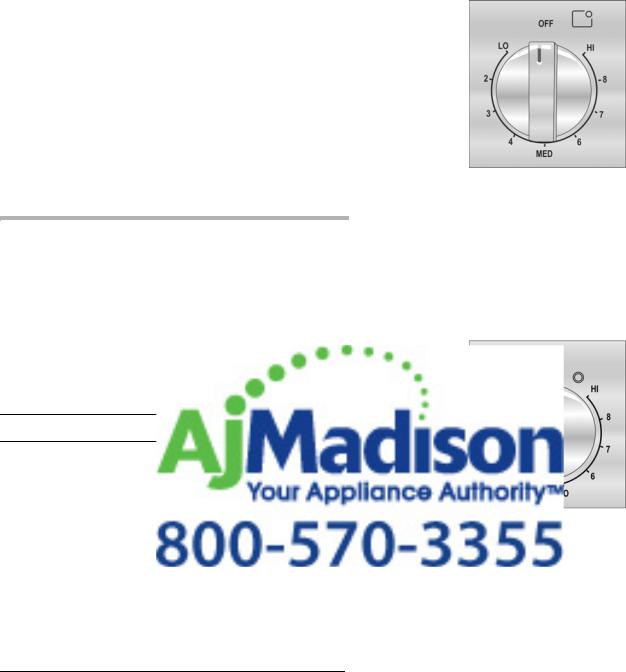
•There may be a slight odor during first uses; this is normal and will disappear.
•Optimum cooking results depend on proper cookware being used.
•The cooking surface will hold the heat and remain hot up to 30 minutes after the elements have been turned off.
•While cool, wipe with a clean, damp cloth and dry.
•Optimum oven cooking results depend on proper bakeware being used.
•Read and understand all safety precautions and Use and Care Manual information prior to operating.
Operation - Cooktop
This section explains how to operate the cooktop. See Getting the Most Out of Your Cooktop” for guidelines to improve cooktop results.
About the Cooktop
Use the cooktop for surface boiling, frying, simmering,
9CAUTION
•Foods packaged placed directly on cooking. Aluminum permanent damage
•Plastic, paper and in contact with a items come in ceramic surface.
•Do not allow pans to boil dry. This can permanently damage the pan, the element and the cooktop glass.
•Failure to operate knobs properly may result in personal injury and damage to the appliance.
Setting the Element Heat Level
Single Element Control Knob
To turn on a single element, push in on the control knob and turn in either direction to the desired heat setting. The small icon above the control knob shows the location of the element controlled by the knob.
Double Element Control Knob
To turn ON the small inner element, push in on the control knob and turn it counterclockwise to the desired heat setting. To turn ON both the inner and the outer elements together, push in on the control knob and turn it clockwise to the desired heat setting. The small icon above the control knob shows the location of the burner controlled by the knob.
(some models)
time to boil and low simmer, all in one element. There are two elements that are the full size of the cooking zone.
To turn ON the lower heating element, push in on the control knob and turn it counterclockwise. Set to desired heat setting from Lo to Med Lo.
To use both elements, push in on the control knob and turn it clockwise. Set to desired heat setting from Hi to Med.
To increase the burner heat, turn on both the inner and outer elements together to or past the MED setting. Push in on the control knob and turn it to the desired setting.
English 10
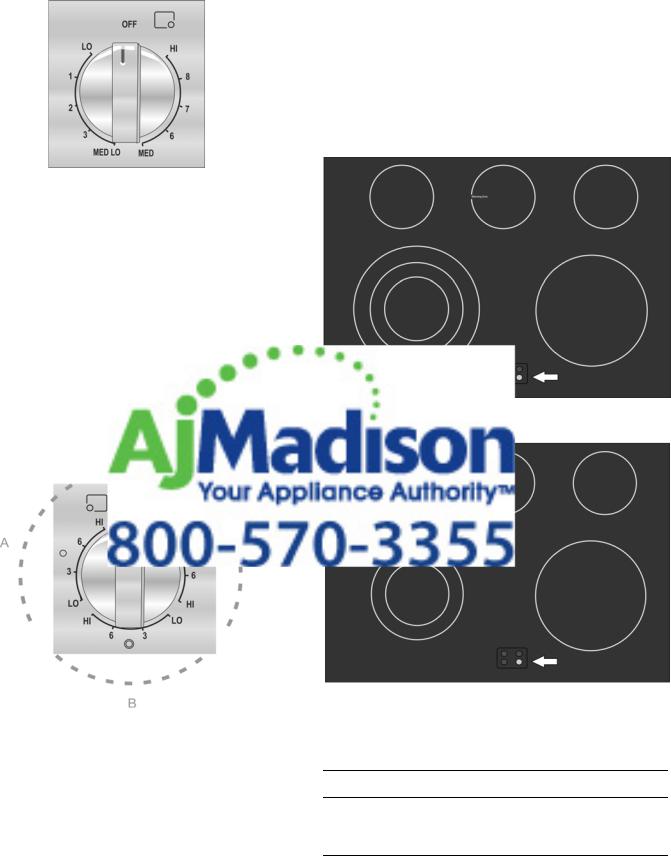
Triple Element Control Knob (some models)
To turn on the small inner element only, push in on the
control knob and turn it to the  symbol (counterclockwise). Turn knob left or right to set the heat level.
symbol (counterclockwise). Turn knob left or right to set the heat level.
To turn on the inner and middle elements, push in and turn
the control knob to the  symbol. Turn knob left or right to set the heat level.
symbol. Turn knob left or right to set the heat level.
To turn on all three elements,
knob to the  icon. Turn level.
icon. Turn level.
For each of the three element temperature can be adjusted more precise temperature
Surface Element On/Hot Indicators
There is an embedded panel near the front of the cooktop with individual lights representing each element. These lights are illluminated when an element is “on”. The light remains on as long as the element is hot. When the element is sufficiently cooled down, the light goes out.
Cooktops with a triple front element
element
Warming Zone
The warming zone is controled through the oven control panel.
To turn on the warming zone
1.Press the Warming Zone touchpad.
2.Press Enter.
To turn off the warming zone
1. Press the Warming Zone touchpad.
English 11
Surface Elements Disabled During Self Clean (some models)
9WARNING
To avoid risk of personal injury, while the self clean cycle is operating, do not operate the cook top and ensure that all surface controls are turned off.
All surface elements are automatically disabled during SelfClean Operation only. This is normal. Once the Self-Clean cycle is complete and the oven has cooled, the elements become operable once again.
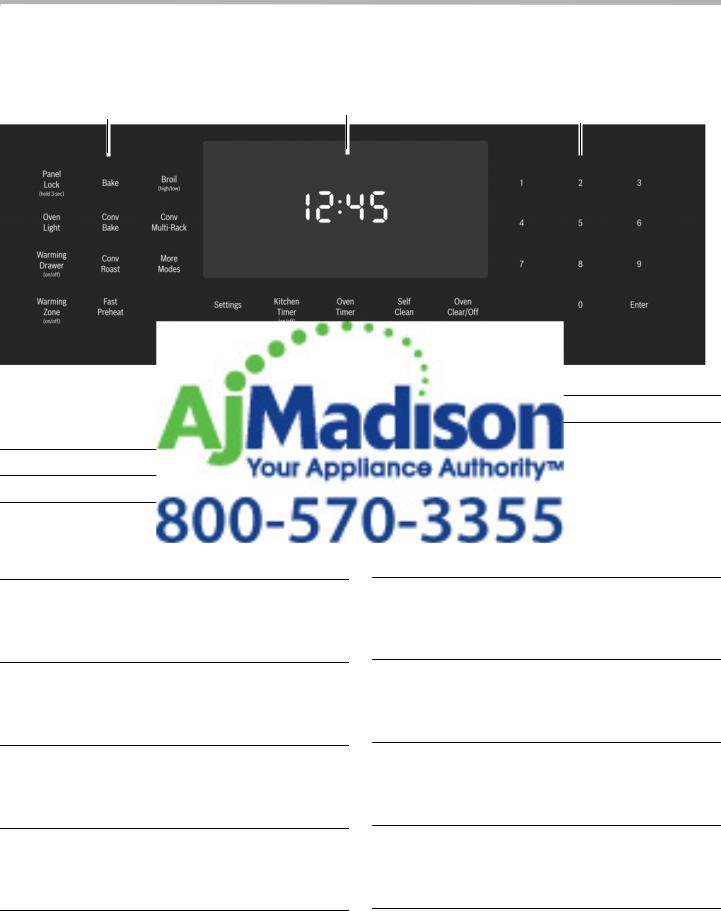
Operation - Oven
Oven Control Panel
1 |
2 |
800 Series Oven Control
1Mode Selection
2Display
3Numeric Keypad
Touchpad Descriptions
Turns Panel Lock mode on and off.
Turns the oven lights on or off.
Starts and stops the kitchen timer(s).
Press to edit a timer.
Press to edit the oven timer for the selected oven. Turns off the oven at the end of the specified time.
3
lightly on the touchpads to
Provides access to user settings to allow customization of basic display, language and other features. Use also to set the clock.
Sets probe target temperature.
Probe allows monitoring of internal meat temperature during cooking.
Enables Fast Preheat option.
Activates Self Clean mode.
English 12
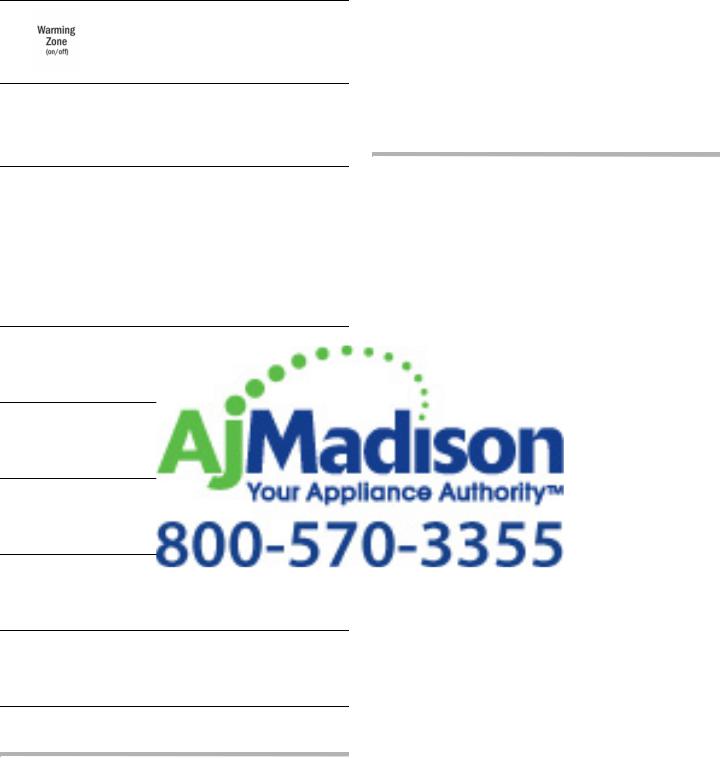
Activates warming zone on cooktop.
Allows access to cooking/heating modes that do not have a direct access touchpad.
More Modes
Additional modes are available by pressing the More Modes touchpad. These modes include Convection Broil, Warm, Pizza, Proof Dough and Roast. These are discussed in the Getting the Most Out of Your Appliance section later in this manual.
Display Symbols
Door Lock - Is displayed when the oven
Fast when
Probe probe
Panel
control panel is locked.
Self Clean - Is displayed when Self
Clean is active.
Before Using the Oven for the First Time
•Oven must be properly installed by a qualified technician before use.
•Remove all packing materials from inside and outside the oven.
•While cool, wipe with a clean, damp cloth and dry.
English 13
•There may be a slight odor during first uses; this is normal and will disappear.
•Optimum cooking results depend on proper bakeware being used.
•Read and understand all safety precautions and Use and Care Manual information prior to operating.
Operation
About the Oven
Your new oven combines premium cooking results and simple operation.
The oven design has been optimized to improve heat distribution in the oven cavity. The result is even browning, shorter cooking times and lower energy consumption.
hours of scrubbing into the thing of the past. The oven ll that is left to do is to when Self-Clean is
makes operating the oven all instructions for
any questions. Our the beginning of this
comments and suggestions!
Basic Features
Setting the Clock
The oven includes time functions that require the current time to be set. It is therefore important to set the clock before beginning to use the oven. The oven cannot be in a cooking mode to access the clock set mode.
To set the clock:
1.The oven must be in Stand-By mode (oven is powered on, but no cooking mode or timer in operation).
2.To access the clock set mode:
Press the Settings touchpad. The display shows “SET CLOCK”. Press Enter to edit the clock.
3.Use the numeric keypad to enter the desired time. Each number pressed is entered at the right and moving previously entered digits to the left. To set “12:45 pm”, press 1, 2, 4, 5.
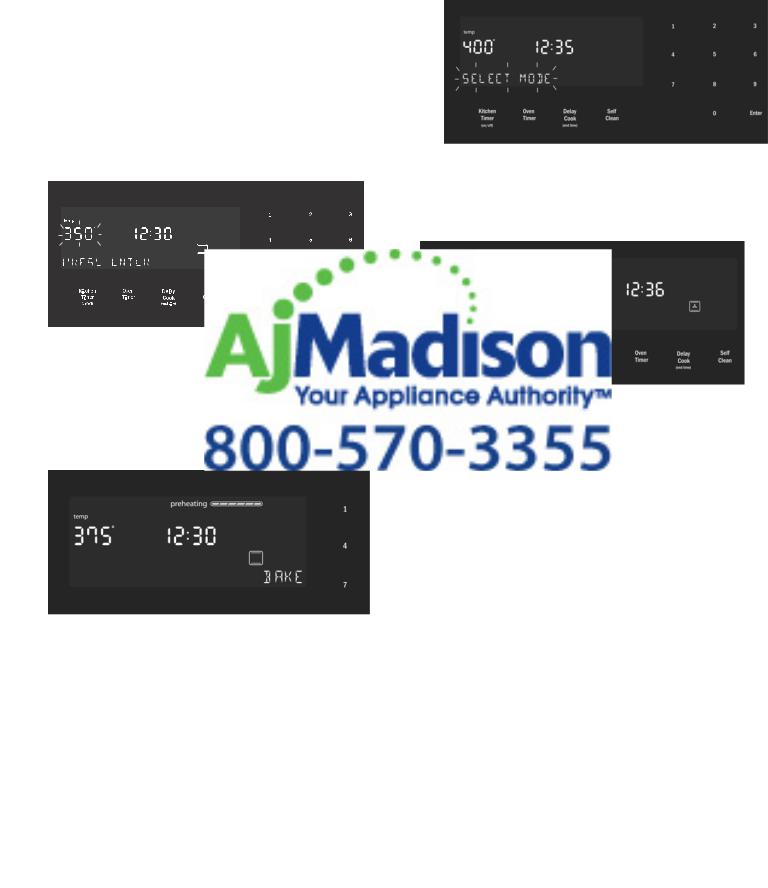
4.When the desired time is entered, set the time by pressing Enter.
The clock is now set and running.
Setting the Cooking Mode and
Temperature
There are two alternate methods to set cooking mode and temperature.
To set the Cooking Mode first, then the temperature:
1.Press the desired Cooking Mode Touchpad. The cooking mode and default temperature are displayed. The temperature flashes to show it can be edited.
2.Press Enter to start the temperature.
3.To change the temperature, using the numeric example. Press Enter
Note: The new temperature 10 seconds if Enter is
4.Preheating starts.
2.Select a cooking mode that is compatible with the temperature entered. If no cooking mode is selected within 5 seconds of setting the temperature, an error tone sounds and a SELECT MODE message is displayed and blinks.
3.Press a Mode Selection Touchpad to select a cooking mode.
The new mode and temperature set automatically after 10 seconds if Enter is not pressed.
that is not within the an error tone will
screen will display “TEMP
Note: If a temperature is entered that is not within the allowed range for the mode an error tone will sound and the lower part of the screen will display “TEMP NOT ALLOWED”.
To set the Temperature first and then the Cooking Mode: (not for Broil or Convection Broil)
1.Press the numeric keys to enter the desired temperature setting. The temperature entered is displayed beside the current time.
Heating Time Limitation
The maximum heating time is limited. If you forget to turn off the oven, it turns off automatically after a set period of time.
The maximum time for Sabbath mode is 74 hours; for all other cooking modes the maximum allowed time is 24
hours.
Temperature in |
Temperature in |
Max. time |
|
allowed without |
|||
ºF |
ºC |
||
activity |
|||
|
|
||
|
|
|
|
100–200 |
30–120 |
24 hours |
|
|
|
|
|
201–550 |
121–300 |
12 hours |
|
|
|
|
English 14
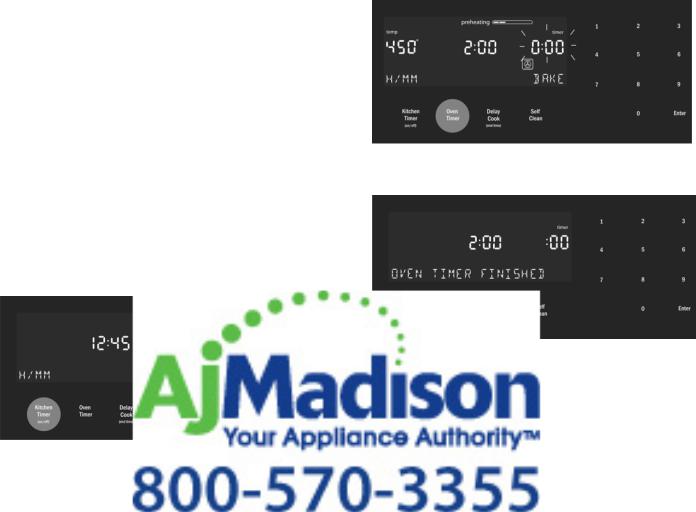
Timer
Your new oven is equipped with two types of timers.
Kitchen Timer - is a countdown timer that has no affect on oven heating. The kitchen timer is used for general kitchen timing needs.
Oven Timer - is a countdown timer which upon reaching 00:00 turns the oven off, stopping the current mode. The oven timer is used to set how long a mode will run. Not available for Broil, Convection Broil, or Proof.
To set a kitchen timer:
(for general kitchen timer needs)
1.Press the Kitchen Timer On/Off.
0:00 is displayed and blinks in the display. Enter the desired timer value in H/MM format using the numeric keypad.
2.Press Enter.
The kitchen timer starts
3.When the kitchen timer
alarm tone sounds every 10 seconds for 2 minutes and the message “TIMER END” is displayed.
Cancel the kitchen timer - by pressing the Kitchen Timer On/Off button.
Note
•The timer does not change when other settings are changed.
To edit an kitchen timer:
1.Press the Kitchen Timer On/Off button.
2.The current time value blinks and can be edited.
To set an oven timer:
(for setting a timer to turn the oven off)
Note: An oven timer cannot be run during Self Clean.
1.Press the Oven Timer touchpad.
2.Select mode, press Enter.
English 15
0:00 is displayed and blinks in the display. Enter the desired timer value in H/MM format using the numeric keypad.
Press the Enter touchpad. The oven timer counts down to 0:00.
the cooking mode ends TIMER FINISHED” is
tone sounds every 10
the oven timer is running to be changed, enter the the Oven Timer
blinks, indicating it can be restart the timer by
. The oven timer may be
cleared by entering 0:00.
Fast Preheat
Fast Preheat heats the oven quicker than standard preheat. It is available for Bake, Convection Multi Rack, Convection Bake, Convection Roast, Roast, and Pizza (Roast is found in the “More Modes” menu). If Fast Preheat is not allowed for the selected cooking mode an error tone sounds. Fast Preheat is not available for Broil, Convection Broil, Proof Dough or Warm.
To set Fast Preheat:
1.Press Fast Preheat.
The fast preheat icon&appears in the display just above the mode name.
2.Press Start.
Fast Preheat can be turned off by pressing Fast Preheat again.
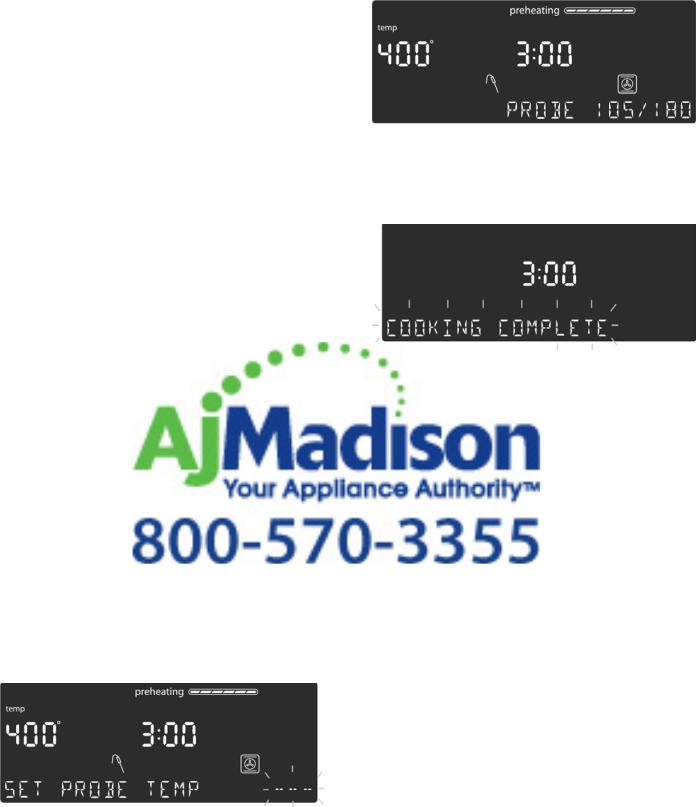
Special Features
The special features provide you with additional conveniences when cooking.
Learn more about these special features in the following sections:
•Probe (some models)
•Sabbath Mode
•Panel Lock
Probe (some models)
The probe measures the internal temperature of the food. The probe is available for Bake, Roast and all convection cooking modes except Convection Broil.
Inserting the probe:
Insert the tip of the probe in the middle and thickest part of the meat or the breast for
not touching fat, bone, or
To use the probe:
1.Insert the probe into the
2.Connect the probe to connected to the oven error tone sounds and is displayed.
3.The Set Probe Temp input prompt “- - -” blinks the numeric keypad to
temperature and press Enter on the numeric keypad.
4.Set the cooking mode and temperature.
Note: The minimum probe temperature that can be set is 100° F (40° C) and the maximum is 200° F (100° C). If the probe temperature entered is outside this range, an error is displayed.
5.The probe current temperature and target temperature are both displayed in the format “105 / 180” at the lower right corner of the display. The actual temperature will display < 80 until the food temperature reaches 80³ F.
The displayed probe temperature is updated in increments of 5° during the cooking process.
6.When the probe temperature reaches the set temperature, the cooking mode turns off. The current time is displayed and the message “COOKING COMPLETE” blinks at the bottom left of the display. An alarm tone sounds every 10 seconds for 2 minutes.
display until it is cleared by touchpad or until the
then goes back to stand
an Oven Timer has been
press the Probe probe temperature message “SET PROBE temperature and press
.
•Do not store the probe in the oven.
•Always use the handle of the probe for inserting and removing.
•Always use a potholder to remove the probe since it becomes hot.
English 16
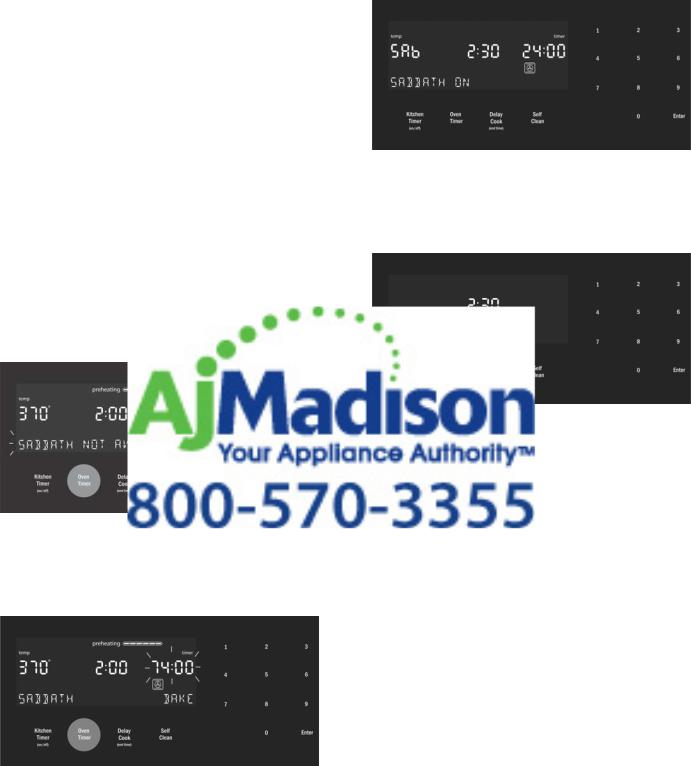
Sabbath Mode
The Sabbath mode enables those of particular faiths to use their ovens on the Sabbath.
The Sabbath mode can be entered in a Bake mode only. The bake temperature must be within the Sabbath mode temperature range of 100° to 450° F.
If the oven light is on during setup, it remains on throughout the Sabbath mode operation. If the oven light is off during setup, it remains off throughout the Sabbath mode operation.
To set the Sabbath Mode:
No kitchen timers or oven timers may be running when Sabbath mode is entered.
1.Begin a Bake operation. While Bake is running, press and hold the Oven Timer touchpad for five seconds.
If a timer is running when start, the display blinks AVAILABLE”.
3.Once Sabbath mode has begun, the display changes to show the message “SABBATH ON”.
4.After the Sabbath mode countdown reaches zero, the oven displays the current time and the message “SABBATH”. No user input is accepted in this state. To end the Sabbath Mode and return to normal function, press the Oven Clear/Off touchpad.
Mode is 100° F to 450° F. be set between 0:01 and
If no timers are running,
appear in the display. The Sabbath Mode timer blinks showing the value can be edited. The default value is 74:00 (the maximum number of hours for which Sabbath Mode can be set.)
2.Press Enter to accept the default 74:00 hours and start Sabbath Mode. Or use the numeric keypad to enter the desired Sabbath mode timer value. Timer values between 0:01 and 74:00 can be entered.
Note: If no changes are made within 10 seconds, Sabbath Mode auto starts.
English 17
While editing the temperature in Sabbath mode, there is no feedback from the control. If an invalid temperature is set, the oven will default back to the previous running temperature.
1.Press the Bake touchpad.
2.Enter the new desired set temperature.
3.Press Enter.
The oven will adjust its set temperature after a randomized delay.
Panel Lock
Allows the user to disable all buttons on the control panel. Panel Lock can only be enabled in stand by mode
1.To enable Panel Lock, press and hold the Panel Lock touchpad for 3 seconds (in stand by mode).
2.To disable Panel Lock, press and hold the Panel Lock touchpad for 3 seconds. The display returns to stand by mode.
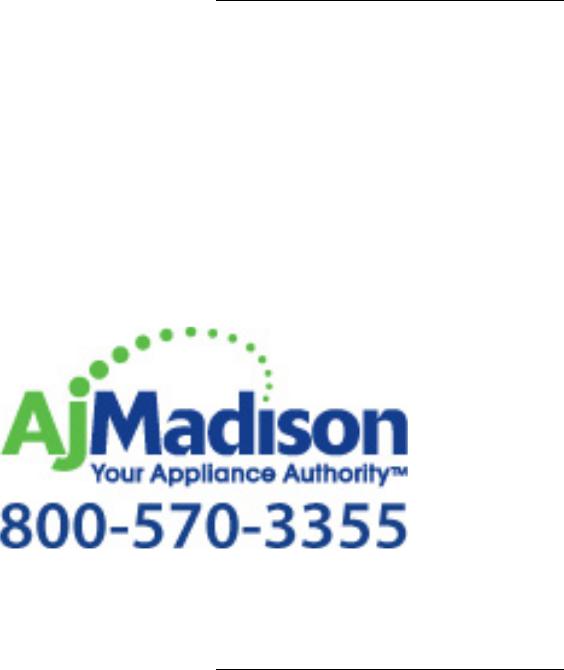
Settings
The oven setup menu is used to customize certain oven settings.
The oven must be in Stand by mode (no cooking mode or timer running) in order to access the setup menu.
To make changes to Settings Menu Items:
1.Press the Settings touchpad.
2.The first setup item is displayed. The display shows “SET CLOCK”. Press Settings again to access the settings menu.
3.To display a different setup item, press the number corresponding to that setting (see table following or press the Settings touchpad to cycle through available options).
4.To change the value for the displayed setting press the Enter touchpad to enter the edit mode. Use the numeric keypad to change the setting value. The corresponding setting
following.
For the temperature press “-” or “+” first, then
The new value is reverts from edit mode
To exit the Settings menu:
Press the Clear On/Off
Settings Menu Options
|
Menu Item |
Description |
Default |
1 |
Temperature |
Fahrenheit (° F) or |
°F |
|
Mode |
Celsius (° C) |
|
|
|
|
|
2 |
Brightness |
High, Medium, Low |
High |
|
|
|
|
3 |
Volume |
High, Medium, Low |
MED |
|
|
|
|
4 |
Clock mode |
12-hour or 24-hour display |
12HR |
|
|
mode. 12HR, 24HR. |
|
|
|
|
|
5 |
Auto |
Decreases oven temperature |
OFF |
|
Convection |
by 25° F for Convection Bake |
|
|
Conversion |
and Convection Multi-Rack |
|
|
|
cooking modes. On, Off. |
|
|
|
|
|
6 |
Button Beep |
Tone when touchpad is |
OFF |
|
|
pressed. On, Off. |
|
|
|
|
|
7 |
Stand by |
Clock displays when no |
ON |
|
|
or timer is in |
|
|
|
. |
|
|
|
|
|
|
|
setting: English, |
EN |
|
|
(FR) |
|
|
|
|
|
|
|
temperature offset |
0 |
|
|
Convection |
|
|
|
Convection |
|
|
|
Convection Multi- |
|
|
|
an offset value is |
|
|
|
actual oven |
|
|
|
increased or |
|
|
|
this value. This |
|
|
Example: |
useful if food is |
|
|
consistently either too brown |
|
|
|
5° F is |
or too light. |
|
|
entered as |
The range for changing the |
|
|
05. |
offset is between +/- 35° F (+/ |
|
- 19° C) in 1° increments. The default value is 0.
English 18
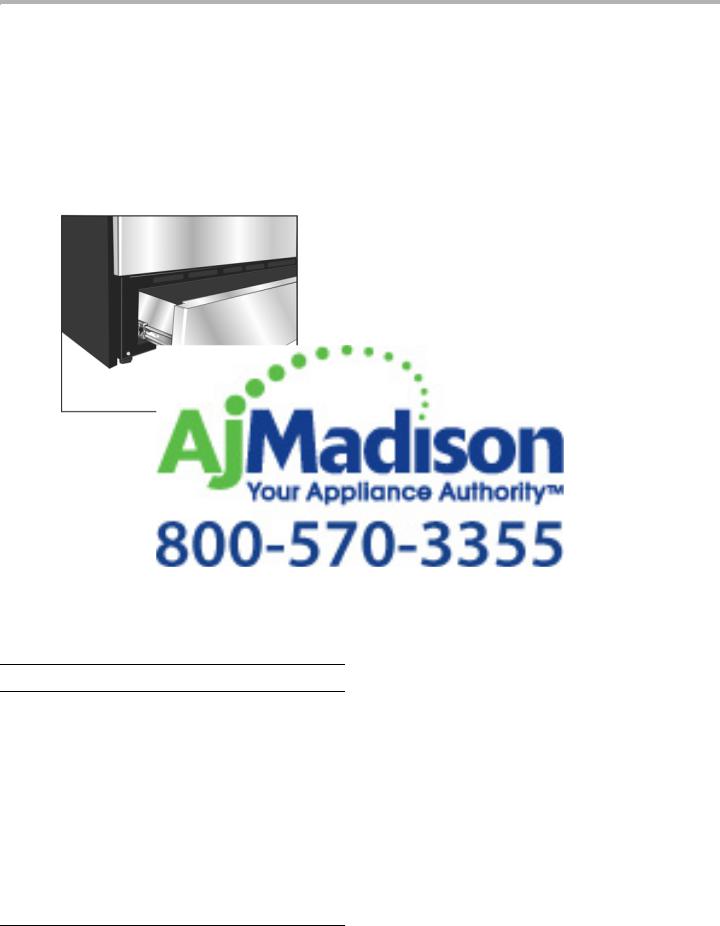
Operation - Warming Drawer
This section explains how to operate the warming drawer. See “Getting the Most Out of Your Warming Drawer” on page 43 for guidelines to improve warming drawer results.
About the Warming Drawer
The warming drawer will keep hot, cooked foods at serving temperature. Warming drawer settings are Low, Medium, and High.
Preheating
For best results, preheat the warming drawer when warming food.
Preheat Times:
•Low: 10 minutes
•Medium: 15 minutes
•High: 20 minutes
Warming Drawer
Drawer Interior: 25" W x
Dish sizes:
•2 -9 x 13" Pyrex 3-quart
•2 -9 1/2 x 15" Pyrex 4-
•4 -10 1/2" plates, single or stacked
•3 -11" plates, single or stacked
Operation
9CAUTION
To maintain food safety, follow these guidelines:
•DO NOT use the warming drawer to heat cold food (exception: it is safe to use the drawer to crisp crackers, chips or dry cereal and to warm plates).
•Be sure to maintain proper food temperature. The USDA recommends holding hot food at 140°F or warmer.
•DO NOT warm food for longer than one hour.
•Plastic containers, plastic wrap or aluminum foil can melt if in direct contact with the drawer or a hot cooking container. If it melts onto the drawer, it may not be removable.
Turning Warming Drawer On and Off
1.Press the Warming Drawer touchpad.
2.WARMING DRAWER will be displayed with the default setting “MED”. The warming drawer amber icon is displayed below the clock.
3.To accept the “MED” setting, press the “Enter”
keypad. The setting is drawer icon remains essed, the warming drawer the warming drawer turns
“MED” is displayed, press again. The setting warming drawer
setting to “LOW”. To Enter key on the numeric
g will be accepted and the minated below the clock, drawer is active.
5.To turn the warming drawer off, press the warming drawer touchpad and the warming drawer will turn off and the warming drawer icon will no longer appear under the clock.
Warming Empty Serving Bowls and
Plates
•Use only heat-safe dishes.
•Warm on low setting for cooking containers.
•Check dish temperature during warming period.
•Place empty plates or dishes in a cold warming drawer. Do not preheat drawer prior to placing dishes.
English 19

Getting the Most Out of Your Cooktop
Cooktop Cooking Guide |
Cookware Selection Guide |
Boiling Water
Time to boil can vary greatly depending on environmental conditions. Try the following tips to decrease boil time:
•Use a lid.
•Use a pan that is appropriately sized for the amount of water and the size of the element.
•Select a pan with a flat base (See “Cookware Selection Guide” in the next column for details).
•Choose a medium-weight pan (rather than a heavyweight one).
•Make sure that the pan is positioned so that the entire base is in contact with the element.
•Start with water that is
•Boil the smallest amount volumes will boil faster
Recommended Settings
Use this chart as a guide settings are listed because
•type and quality of pan
•type, quantity and temp
•element used and
•the cook’s preference.
The Heat Settings recommended are based on a 240 volt power source. If your cooktop is connected to 208 volts, the same heat settings apply but foods may take a little longer to finish cooking.
Table 1: Cooking Guide
Uses |
Heat Settings |
|
|
|
|
Bringing water to boil |
9 - High |
|
|
|
|
Pan frying, sautéing, browning |
6-8 |
- Med-High |
meat, deep fat frying |
|
|
|
|
|
Most frying, eggs, pancakes, |
4-5 |
- Med |
slow boil |
|
|
|
|
|
Simmering, finish cooking, |
2-3 |
- Med Low |
covered foods, steaming |
|
|
|
|
|
Melting butter and chocolate |
1 - Low |
|
|
|
|
Cookware Characteristics
Pan selection directly affects cooking speed and uniformity. For best results select pans with flat bases. When a pan is hot, the base (pan bottom) should rest evenly on the surface without wobbling (rocking). Flat, medium-to-heavy- weight pans are best.
To Test the Flatness of Your Pans
Turn the pan upside down on the countertop and place a ruler flat against the bottom of the pan. The bottom of the pan and the straight edge of the ruler should be flush
cookware will have an the bottom surface area.
of the pan should cover element being used. Pans
may overhang the element area by 1" (25.4 mm) all around.
Tight Fitting Lids – A lid shortens cooking/boiling time by holding heat inside the pot.
Cookware Tips
•Use of pots and pans with rounded (either concave or convex) warped or dented bottoms should be avoided.
•Make sure the bottom of the pot or pan being used is clean and dry.
•Use pots and pans with thick, smooth metal bottoms.
•Do not slide metal pots across the cooktop. Pans may leave marks which need to be removed immediately. See Care and Cleaning Section.
•Do not use glass pans as they may scratch the surface.
Specialty Pans
Specialty pans such as griddles, roasters, pressure cookers, woks, water bath canners and pressure canners
English 20
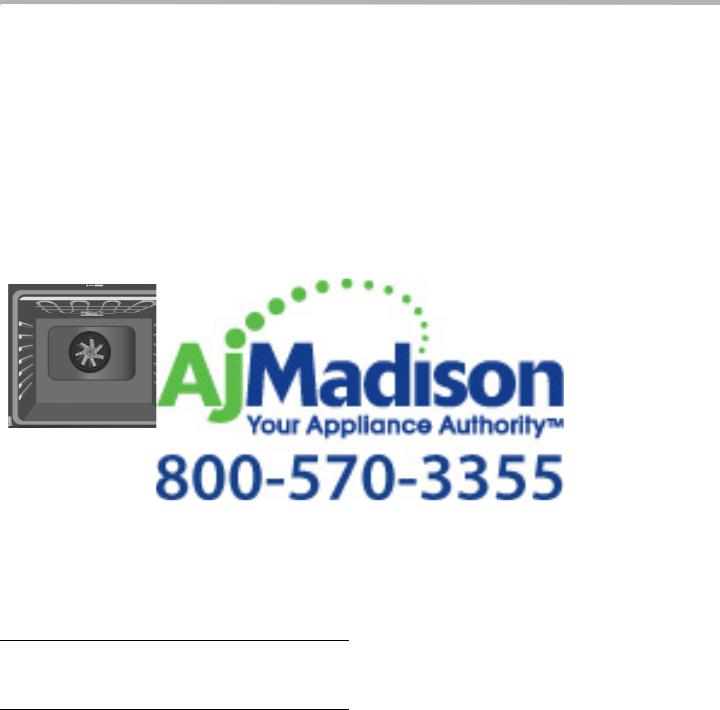
must have the same features as described above. Use only a flat-bottomed wok. Never place a support ring, such as a wok ring or trivet, on the cooking surface.
Getting the Most Out of Your Oven
General Tips
Pan Placement
Baking results are better if pans are placed in the center of the oven. If baking more than one pan on a rack, allow at least 1" to 1 ½" of air space around the pan. When baking four cake layers at the same time, stagger pans on two racks so that one pan is not directly above the other.
Rack Position
The rail at the top of the top rack (position 6). Use DO NOT attempt to use the rack.
Rack Position |
Best For |
|
|
6 (highest |
hamburgers, steaks, melting cheese, |
usable position) |
browning toppings |
|
|
5 |
toasting bread, broiling most meats |
|
|
4 |
broiling poultry and thicker meats |
3most baked goods on a cookie sheet or baking pan using a single rack, includes frozen convenience foods, cakes, casseroles, frozen pizza
2small roasts or poultry, bundt cakes, pies, breads
1 (lowest |
large roasts, turkey, angel food cake |
position) |
|
|
|
Aluminum Foil
Do not use aluminum foil or protective liners to line any part of the appliance, especially the oven bottom. Installing these liners may result in risk of electric shock or fire.
Preheating the Oven
•Place oven racks in desired position before heating the oven.
•Preheat the oven when using the Bake, Convection Bake, Convection Multi Rack, Pizza, Broil, Convection Broil, and Warm modes.
Convection Roast and
preparing recipe
does not shorten preheat
food in the oven as the loss of heat and
.
up preheating time.
Your oven has one of the fastest preheat times in the market using a concealed bake element. The lower element is hidden under the oven bottom. It is normal that the preheat time is different than your previous oven that had an exposed element on the bottom.
•Cleaning the oven is easier because there is no cleaning around a coil element showing on the bottom of the oven. The hidden lower element is protected from food soils and spills. Wiping up excess spills is easy.
•Preheating is not necessary for meats, poultry, casseroles and frozen foods.
•Preheat time will be longer when the electrical supply to your house is less than 240 volts.
•Increasing the oven temperature will require a longer preheat time. For example, the preheat time for 425° F is longer than the preheat time for 350³ F.
When broiling, preheat the oven 3-4 minutes. Do not preheat for more than 5 minutes.
English 21
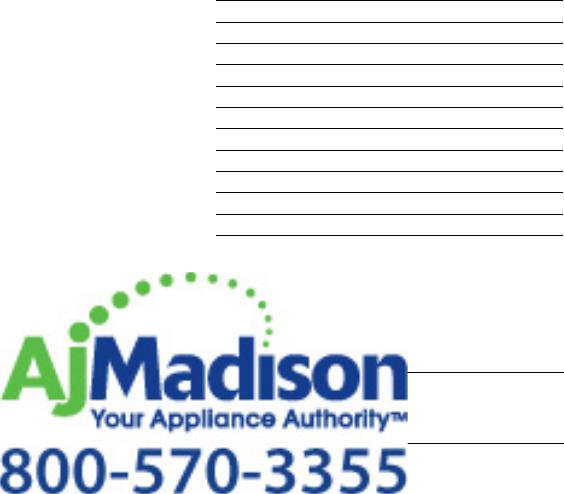
For Best Results
•Use the cooking recommendations as a guide.
•Open the door as briefly as possible to avoid temperature reduction.
•Use the interior oven light to view the food through the oven window rather than opening the door frequently.
•Use the Timer to keep track of cooking times.
Baking Pans and Dishes
•Glass baking dishes absorb heat. Reduce oven temperature 25° F when baking using glass dishes.
•Preheat the oven before adding glass baking dishes.
•Use pans that provide the desired browning. For tender, light, golden-brown crusts, use light, anodized or shiny metal bakeware.
•Dark, rough or dull pans (nonstick or anodized) will absorb heat and result in a browner, crisper crust. Some manufacturers recommend reducing the temperature 25 ºF when using this type of pan. Follow manufacturers'
•Insulated cookie sheets length of cooking time.
•Do not set any heavy
•Do not keep empty pans during cooking as this performance. Store pans
Opening the Oven
--Open and close the door handle. To avoid other parts of the door.
High Altitude Baking
•When cooking at high altitudes, recipes and cooking times will vary.
•For accurate information, write the Extension Service, Colorado State University, Fort Collins, Colorado 80521. There may be a cost for the guides. Specify which high altitude food preparation guide you prefer: general information, cakes, cookies, breads, etc.
Condensation
•It is normal for a certain amount of moisture to evaporate from the food during any cooking process. The amount depends on the moisture content of the food. The moisture may condense on any surface cooler than the inside of the oven, such as the control panel.
Temperature Range by Cooking Mode
Temperatures shown are in Fahrenheit.
Mode |
Lowest |
Highest |
Bake |
100 |
550 |
Roast |
100 |
550 |
Broil (Low, High) |
450 |
550 |
Warm |
150 |
225 |
Proof |
85 |
125 |
Convection Bake |
100 |
550 |
Convection Multi-Rack |
100 |
550 |
Convection Roast |
100 |
550 |
Pizza |
100 |
550 |
Convection Broil (Low,High) |
450 |
550 |
with dry, heated air. and lower elements
the oven
prepare a variety of food
. Refer to recipe or package directions for oven temperature and baking time.
Tips
•Preheat the oven if the recipe recommends it.
•Baking time will vary with the size, shape and finish of the bakeware. Dark metal pans or nonstick coatings will cook faster with darker results. Insulated bakeware will lengthen the cook time for most foods.
•For best results, bake food on a single rack with at least 1 1/2” space between pans or dishes and oven walls.
•Eliminate heat loss from the oven by using the window to periodically check food for doneness instead of opening the door.
Auto Convection Conversion
Convection Bake and Convection Multi-Rack modes require a 25° F reduction in temperature. Auto Convection Conversion reduces the temperature you enter automatically. Simply enter the package or recipe
English 22
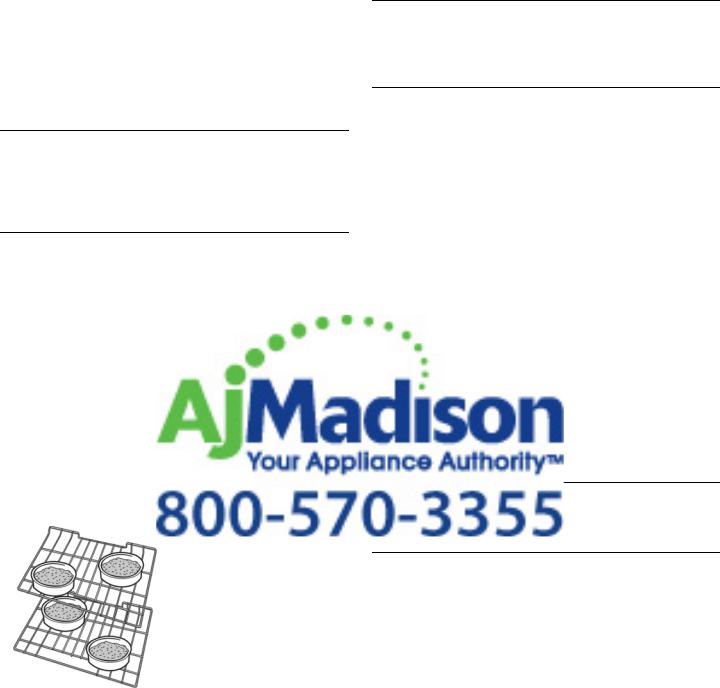
temperature when setting the mode. The control calculates the correct temperature and it is shown in the display.
•The Auto Convection Conversion feature can be turned on to allow for automatic temperature adjustments. See “Auto Convection Conversion” in the “Settings” section for details
Convection Bake
Convection Bake is similar to Bake.
2Heat comes from the upper and lower heating elements. The main difference in convection baking is that the heat is circulated throughout the oven by the convection fan.
The Convection Bake mode is well suited for cakes, bar cookies and breads to take advantage of the bottom heat, yielding a better crust on baked items.
The benefits of Convection Bake include:
--Slight decrease in cook
--Higher volume (yeast
Tips
•Place food in shallow, sheet without sides.
•For cakes use rack
•If baking more than one to 1 1/2” of air space that one is not directly below). Use these rack
.
English 23
Convection Multi-Rack
Multi-Rack mode cooks with heat
:from a third element behind the back wall of the oven. The heat is circulated throughout the oven by the convection fan.
The Convection Multi-rack mode is well suited for cooking individual serving-sized foods such as cookies and biscuits. It is also good for cooking on multiple racks (2 or 3) at the same time. Baking cookies is possible on 6 racks simultaneously. In this case, the baking time increases slightly.
The benefits of Multi-Rack include:
--Even browning.
--Time savings as a result of using multiple racks at one time.
Tips
by 25° F if Auto Convection
uncovered pans such as
on a rack, allow at least 1” the pan. Stagger pans so the other.
mode, heat from the lower elements is throughout the oven by the fan.
Use the Pizza mode for fresh or frozen pizza.
Tips
•When baking a frozen pizza:
For a crispy crust, place pizza directly on the rack. For a softer crust, use a pizza pan.
•When proofing pizza dough, coat dough with olive oil and cover it in a bowl tightly with plastic wrap to prevent crust formation.
•Sprinkle cornmeal on the pizza pan to prevent sticking.
•If using a pizza paddle, sprinkle the paddle liberally with cornmeal for ease in transferring the dough to the pan.
•If par-baking handmade pizza dough, prick the dough with a fork before baking.
•If using a pizza pan, choose a dark, perforated pan for a more crisp crust and a non-perforated pan for a softer crust.
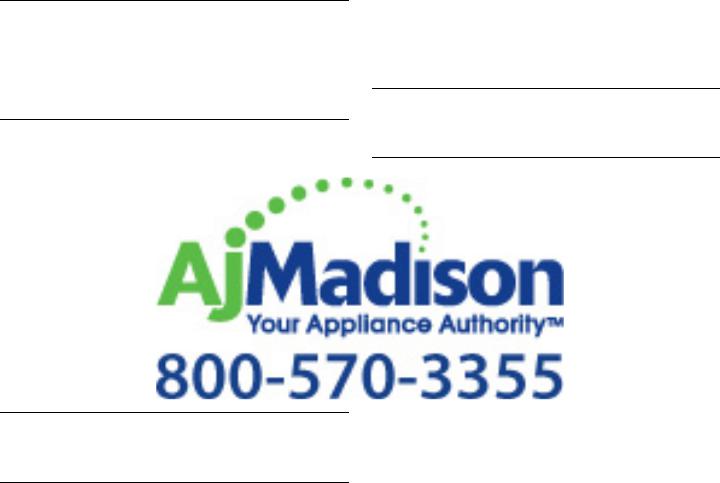
•Preheat baking stones following manufacturer’s recommendations while the oven is preheating.
•Bake homemade pizzas on rack position 2 in the center of the rack.
•Follow manufacturer’s directions for frozen pizza.
•The convection fan cycles on and off when using pizza mode.
Roast
Roast uses both the upper and lower elements to maintain the oven
%intense heat from the upper element than the lower element. This results in
more browning of the exterior while the inside remains especially moist.temperature. Roasting uses more
Roast is best suited for meat and poultry and less tender cuts of meat.
Tips:
•Preheating the oven is
•Use a high-sided broil with a lid or foil for less
•For less tender cuts of juice, wine, bouillon or
•Roasting bags and using this mode.
•When roasting whole behind back and loosely
Convection
Convection Roast uses heat from
2the top and bottom elements as well as heat circulated by the convection fan.
The Convection Roast mode is well suited for preparing tender cuts of meat and poultry. It is also suitable for roasting vegetables.
The benefits of Convection Roast include:
--As much as 25% faster cooking than non-convection modes.
--Rich, golden browning.
Tips:
•Preheating the oven is not necessary.
•Use the same temperature as indicated in the recipe.
•Check doneness early, since roasting time may decrease. Refer to the Meat/Poultry cooking chart for examples.
•Do not cover meat or use cooking bags.
•Use a broil pan with a rack and grid or a shallow, uncovered pan with a rack for roasting.
•Use a meat thermometer to determine the internal termperature of the meat.
•If the meat is browned to your liking, but is not yet done, a small strip of foil can be placed over the meat to prevent overbrowning.
•Let meat stand covered with foil for 10 to 15 minutes after removing it from the oven.
•Refer to the Meat/Poultry Cooking Chart for recommended rack positions.
Broil
(Broil uses intense heat radiated from the upper element.
cooking thin, tender cuts fish. It can also be used to
Always broil with the door include:
of fats or liquids.
Do not preheat for more
at least ¾" thick.
butter or oil to prevent
sticking.
•Use a broil pan and grid, or a deep pan with a metal rack, for broiling.
•Do not cover the broil grid with foil. It is designed to drain fats and oils away from the cooking surface to prevent smoking and spattering.
•Turn meats (other than fish) once during the recommended cook time. Fish does not need to be turned.
•When top browning casseroles, use only metal or glass ceramic dishes such as CorningWare ®.
•Never use heat-proof glass (Pyrex ®); it cannot tolerate the high temperature.
•For broil times, refer to the Meat/Poultry Cooking Chart.
English 24
